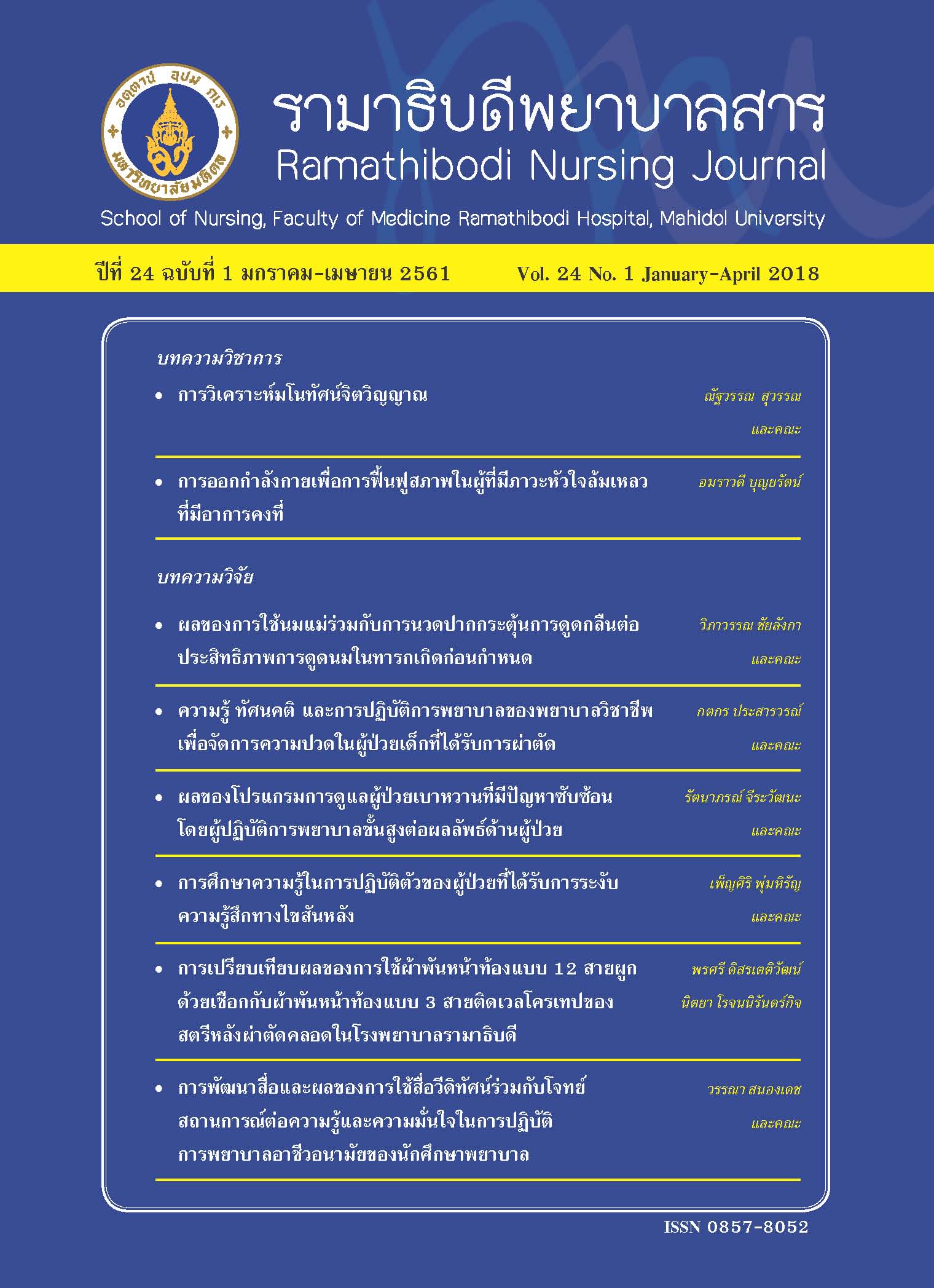Nurses'Knowledge, Attitude, and Nursing Practices for Pain Management for Postoperative Children
Main Article Content
Abstract
บทคัดย่อ : การวิจัยเชิงพรรณนาครั้งนี้มีวัตถุประสงค์เพื่อศึกษาระดับความรู้ ทัศนคติและการปฏิบัติการพยาบาลของพยาบาลวิชาชีพในการจัดการความปวดผู้ป่วยเด็กที่ได้รับการผ่าตัด ศึกษาความสัมพันธ์ระหว่างความรู้ ทัศนคติ และการปฏิบัติการพยาบาลของพยาบาลวิชาชีพในการจัดการความปวดในผู้ป่วยเด็กที่ได้รับการผ่าตัด และศึกษาปัญหาและอุปสรรคของพยาบาลวิชาชีพในการปฏิบัติการพยาบาลเพื่อจัดการความปวดในผู้ป่วยเด็กที่ได้รับการผ่าตัด กลุ่มตัวอย่างคัดเลือกแบบสุ่มโดยวิธีจับฉลากคือ พยาบาลวิชาชีพจำนวน 123 คน ที่ดูแลผู้ป่วยเด็กหลังผ่าตัด และปฏิบัติงานในโรงพยาบาลระดับตติยภูมิ สังกัดกระทรวงสาธารณสุขจำนวน 5 โรงพยาบาลจากทุกภาคในประเทศไทย โดยวิธีการสุ่มเลือกโดยการจับสลาก เครื่องมือวิจัยเป็นแบบสอบถามความรู้ ทัศนคติและการปฏิบัติการพยาบาลในการจัดการความปวดหลังผ่าตัดในผู้ป่วยเด็ก วิเคราะห์ข้อมูลโดยใช้สถิติบรรยาย และหาความสัมพันธ์ด้วยสัมประสิทธิ์สหสัมพันธ์ของเพียร์สัน ผลการวิจัยพบว่า ระดับของความรู้ ทัศนคติของพยาบาลในการจัดการความปวดในเด็กที่ได้รับการผ่าตัดอยู่ในระดับปานกลาง ระดับการปฏิบัติการพยาบาลของพยาบาลวิชาชีพในการจัดการความปวดในเด็กที่ได้รับการผ่าตัดอยู่ในระดับสูง และความรู้ ทัศนคติ มีความสัมพันธ์ทางบวกกับการปฏิบัติการพยาบาลของพยาบาลวิชาชีพในการจัดการความปวดในเด็กที่ได้รับการผ่าตัด อย่างมีนัยสำคัญทางสถิติ (r = .15, p < .05) อุปสรรคของพยาบาลวิชาชีพในการจัดการความปวดในผู้ป่วยเด็กที่ได้รับการผ่าตัด คือ ผู้ป่วยเด็กและผู้ปกครองให้ความร่วมมือในการให้การพยาบาลในการจัดการความปวดน้อย พยาบาลมีความรู้และทักษะไม่เพียงพอในการประเมินความปวดโดยเฉพาะการเลือกเครื่องมือประเมินความปวด และพยาบาลไม่สามารถแยกความแตกต่างของพฤติกรรมการแสดงออกของความปวดในเด็กได้ ข้อเสนอแนะ ควรมีการจัดอบรมการเลือกใช้เครื่องมือในการประเมินความปวดให้เหมาะสมกับวัยของผู้ป่วยแต่ละรายให้กับพยาบาลวิชาชีพ และ ควรมีการจัดทำแนวปฏิบัติการพยาบาลในการประเมินและการจัดการความปวดอย่างชัดเจน
Article Details
บทความ ข้อมูล เนื้อหา รูปภาพ ฯลฯ ที่ได้รับการตีพิมพ์ในรามาธิบดีพยาบาลสาร ถือเป็นลิขสิทธิ์ของวารสาร หากบุคคลหรือหน่วยงานใดต้องการนำทั้งหมดหรือส่วนหนึ่งส่วนใดไปเผยแพร่หรือเพื่อกระทำการใด ใด จะต้องได้รับอนุญาตเป็นลายลักษณ์อักษรจากรามาธิบดีพยาบาลสารก่อนเท่านั้น
References
pain.2010.11.005
2. Mario IO, Ponce-Monter HA, Rangel-Flores E, Castro-Garmez B, Romer-Quezada LC, O’Brien JP. Nurses’ and
nursing students’ knowledge and attitudes regarding pediatric pain. Nurs Res Pract. [cited 2017 Jan 25]; 1-8. Available
from: https://dx.doi.org/10.1155/ 2015/210860
3. Twycross A. Nurses’ views about the barriers and facilitators to effective management of pediatric pain. Pain
Manag Nurs. 2013;14:e164–72.
4. Radnovich R, Chapman CR, Gudin JA, Panchal SJ, Webster LR, Pergdizzi JV. Acute pain: effective management
requires comprehensive assessment. Postgrad Med. 2014;126(4):59-72
5. Kaasalainen S, Martin-Misener R, Carter N, DiCenso A, Donald F, Baxter P. The nurse practitioner role in pain management in long-term care. J Adv Nurs. 2010;66: 542–51.
6. Nimmanrata S, Prechawai C, editors. Pain & pain management. Songkla: Chanmuang; 2005. (in Thai)
7. Lee JY, Jo YY. Attention of postoperative pain control in children. Korean J Anesthesiol. 2014;66:183-8.
8. Soonsawad J. The relationship between nurses perception and nursing intervention for pain relief in post operative children [Thesis]. Nakorn Prathom: Mahidol University; 1997.
9. Ferrell BR, McGuire DB, Donovan MI. Knowledge and beliefs regarding pain in a sample of nursing faculty. J Prof
Nurs. 1993;9:79-88.
10. Chen WL. Nurses’ and parents’ attitudes toward pain management and parental participation in post-operative
care of children [Thesis]. Queensland: The Queensland University of Technology School of Nursing Centre for
Health Research; 2005.
11. Prommalar K, Siripul P, Poungsuwan P. Effects of nurses’ability development program on procedural pain management in premature infant. J NursSci and Health. 2011;34:12-21. (in Thai)
12. Bloom BS. The role of educational science in curriculum development .Int J Educ Sci. 1965;1:5-15.
13. Hozzain S. Nurses’ knowledge and attitudes, and pain management practice of post-operative children in Bangladesh [thesis]. Songkla: Prince of Songkla University; 2010
14. Smyth E, Caamano F, Fernandez-riveiro P. Oral health Knowledge attitude and practice in 12 years-old school
children, Medicana Oral Patologicaloraalycirugia Bucal. 2007;12:614-20.
15. Vincent CVH, Denyes MJ. Relieving children’s pain: nurses’ abilities and analgesic administration practices, Pediatr
Nur. 2004;19:40-50.
16. Cohen, J. Quantitative method in psychology: a power primer. Psychol Bull. 1992;112:155-9.
17. Vincent CVH. Nurses’ knowledge, attitudes, and practices regarding children’s pain. MCN Journal. 2005;30:177-183.
18. Singh IN, Malaviya AN. Long distance truck drivers in India: HIV infection and their possible role in disseminating
HIV into rural areas. Int J STD AIDS. 1994 Mar-Apr; 5(2):137-38.
19. Twycross A. Children’s nurses’ post-operative pain management practices: An observational study. Int J Nur
Studies. 2007;44:869-81.
20. Ferrell BR, McCaffery M. The knowledge and attitudes survey regarding 2012 [cited 2017 Jan 25], Available
from: https://www.midss.org/sites/default/files/knowldege__attitude_survey_10-12.pdf
21. Broome ME, Richtsmeier A, Maikler, V, Alexander M. Pediatric pain practices: A national survey of health
professionals. J Pain Symptom Manag. 1996;11:312-20.
22. NgamkhamS, Khiewchaum R, Boonleau O. Naive nurses’knowledge and attitude about pain assessment and
management. Journal of Phrapokklao Nursing College. 2014; 25:65-72. (in Thai)
23. Maneesri R, Prasertsri N, Pradubthong O. Undergraduate nursing students’ knowledge and attitudes regarding pain
management . Journal of Nursing Division. 2011;39:66-78. (in Thai)
24. Stanley M, Pollard D. Relationship between knowledge, attitudes, and self-efficacy of nurses in the management
of pediatric pain. Pediatr Nur. 2013;39:165-171.
25. Monitto CL, Kost-Byerly S, White E, Lee CKK, Rudek MA, Thompson C, Yester M. The optimal dose of
prophylactic intravenous naloxone in ameliorating opioidinduced side effects in children receiving intravenous
patient-controlled analgesia morphine for moderate to severe pain: a dose finding study. Anesth Analg. 2011;
113(4):834-42.
26. Chatchumni M. Post-operative pain management practice current situation and challenges within nursing practice in
a Thai context [Dissertations]. Sweden: School of Health, Care and Social Welfare Mälardalen University Press; 2005.
27. Lueluang W, Vorahan W. Factors influencing role practices of professional nurses at operating room in regional
hospitals, Northeast Region. Khon kaen University Research Conference 2012. Availiable from: https://gsbooks.gs.kku.ac.th/55/cdgrc13/files/mmo7.pdf
28. Craig JA. Nursing knowledge and attitudes toward pain management. Nursing Theses and Capstone Projects. Paper 8. 2014;1-63.
29. Arif-Rubu M, Fisber, D, Matsuda, Y. Biobehavioral measures for pain in the pediatric patient. Pain Manag
Nurs. 2012 Sep;13(3):157-68.
30. De Freitas GR, de Castro CGJr, Castro SM.&Heineck I. Degree of knowledge of health care professionals about
pain management and use of opioids in pediatrics. Pain Med. 2014;15:807-19.
31. Nugroho FA, Sangchart B. Knowledge, attitudes, and nursing practice regarding postoperative pain management
in Kebumen, Indonesia. J Nurs Health Care. 2016; 34:168-75.
32. Czarnecki ML, Simon K, Thompson JJ, Armus CL, Hanson TC, Berg KA, et al. Barriers to pediatric pain
management: a nursing perspective. Pain Manag Nurs. 2011;12:154-62.
33. Vickers N. Knowledge and attitudes regarding pain among surgical nurses in three teaching hospitals in Ireland[thesis]. Dublin: Dublin City University; 2011.
34. James SR, Ashwill JW, Dorske SC. Nursing care of children principle & practice (2nded). Philadephia: W.B.
Sanders; 2002.
35. Rony RY, Fortier MA, Chorney JM, Perret D, Kain ZN. Parental postoperative pain management: attitudes,
assessment, and management. [Research Support,N.I.H.,Extramural]. Pediatrics. 2010;125(6):e1372-78.
doi:10.1542/peds.2009-2632


